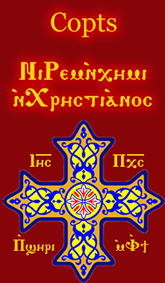Related Research Articles

There have been many Coptic versions of the Bible, including some of the earliest translations into any language. Several different versions were made in the ancient world, with different editions of the Old and New Testament in five of the dialects of Coptic: Bohairic (northern), Fayyumic, Sahidic (southern), Akhmimic and Mesokemic (middle). Biblical books were translated from the Alexandrian Greek version.

Uncial 070, ε 6 (Soden), is a Greek-Coptic diglot uncial manuscript of the New Testament. Palaeographically it has been assigned to the 6th century.

Francis Karl Alter (1749–1804), a Jesuit, born in Silesia, and professor of Greek at Vienna, was an editor of the Greek text of the New Testament. His edition was different from those of Mill, Wettstein, and Griesbach, because he used only the manuscripts housed at the Imperial Library at Vienna. It was the first edition of the Greek New Testament that contained evidence from Slavic manuscripts themselves, as opposed to Christian Frederick Matthaei's editions (1803-7), also claimed to be the first to contain evidence from the Slavic version of the New Testament.
Codex Bodmer III, is a Coptic uncial manuscript of the fourth Gospel, and the first four chapters of Genesis, dated palaeographically to the 4th century. It contains the text of the Gospel of John with some lacunae. It is written in an early Bohairic dialect of Coptic language.
Huntington 17, bilingual Bohairic-Arabic, uncial manuscript of the New Testament, on a paper. It is dated by a colophon to the year 1174. It is the oldest manuscript with complete text of the four Gospels in Bohairic.
Huntington 20, is a Bohairic-Greek, uncial manuscript of the New Testament, on paper. Palaeographically it has been assigned to the 13th century.
Codex Marshall Or. 5, is a Bohairic-Greek, uncial manuscript of the New Testament, on a paper. Palaeographically it has been assigned to the 14th century.
Codex Marshall Or. 6, is a Bohairic-Greek, uncial manuscript of the New Testament, on a paper. It is dated by the Colophon to the year 1320.
Minuscule 599 (in the Gregory-Aland numbering), A599 (von Soden), is a Greek minuscule manuscript of the New Testament, on paper. Palaeographically it has been assigned to the 15th century. The manuscript has complex contents. It was labelled by Scrivener as 467. It has marginalia.
British Library, Add MS 14448, designated by number 64 on the list of Wright, is a Syriac manuscript of the New Testament, on parchment, according to the Peshitta version. It is dated by a Colophon to the year 699 or 700. The manuscript is a lacunose. Gregory labelled it by 14e, 9a, and 8p . The codex is in the British Library as Add MS 14448.
Codex Marshall Or. 6, is a Bohairic, uncial manuscript of the New Testament, on a paper. Palaeographically it has been assigned to the 16th century.
George William Horner (1849–1930) was a British biblical scholar, an editor of the text of the New Testament in the dialects of the Coptic language.

Codex Oriental Ms. 424, designated by siglum A1 (Horner), t (de Lagarde [= Boetticher]), is written in two languages Bohairic-Arabic, uncial manuscript of the New Testament, on paper. It is dated by a colophon to the year 1308. Many leaves of the codex were lost.
Oriental MS 425, is a bilinguical Bohairic-Arabic, uncial manuscript of the New Testament, on paper, now in the British Library in London. It is dated by a colophon to the year 1308. The manuscript is lacunose.
Oriental MS 1001, Bohairic, uncial manuscript of the New Testament, on paper. Palaeographically it has been assigned to the 12th century. Several leaves of the codex were lost. Horner designated the manuscript by siglum E2.
Add MS 5995, bilingual Bohairic-Arabic, uncial manuscript of the New Testament, on paper. It is dated to the fourteenth century. The manuscript has complex contents.
Add MS 14470, Bohairic, uncial manuscript of the New Testament, with a few Armenian fragments. The manuscript is written on vellum and paper. Palaeographically it has been assigned to the 5th or 6th century. The manuscript has survived in a fragmentary condition. It is now in the British Library as Add MS 14470, under the title "PART Of the Gospel of St. John, the Epistles of St. Paul, and the Acts of the Apostles, Peshito version; imperfect". It forms part of the series Add MS 14425-14741, described in the British Library catalogue as "Manuscripts obtained from the Syrian Monastery of St. Mary Deipara, in the Desert of Nitria, or Scete".
Oriental MS 1001, Bohairic-Arabic, uncial manuscript of the New Testament, on paper. It is dated to the year 1663. Horner designated the manuscript by siglum H3.
Codex Copticus Tischendorfianus I is a Coptic uncial manuscript of the four Gospels, dated palaeographically to the 10th or 11th century. Originally it contained the text of the four Gospels. It is written in Sahidic dialect of Coptic language. It is classified on the list of Coptic manuscripts of the New Testament on the position sa 181. The manuscript has survived in a fragmentary condition.
References
- 1 2 Gregory, Caspar René (1902). Textkritik des Neuen Testaments. 2. Leipzig. pp. 538–539.
- 1 2 Scrivener, Frederick Henry Ambrose; Edward Miller (1894). A Plain Introduction to the Criticism of the New Testament, Vol. 2. London: George Bell & Sons. p. 112.
- 1 2 George Horner, The Coptic Version of the New Testament in the Northern Dialect, otherwise called Memphitic and Bohairic, 1 vol. (1898), p. CXX
- ↑ Constantin von Tischendorf, Editio Octava maiora, vol. III, p. 870.